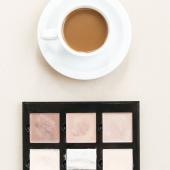What is Bioaccumulation and why does it matter?
This is a simplified explanation of a very important subject. For a deeper deep-dive on toxicity in general, I highly recommend The Dose Makes the Poison by Patricia Frank and M. Alice Ottoboni.
The beauty world is now saturated with products that are "free from" this and "free from" that. But why do we care? Why does choosing "clean" products matter?
Explaining the "Safe Dose"
It's not just that cosmetics may contain harmful ingredients that can be carcinogenic, endocrine disrupting, neuro-toxic, developmentally-toxic, etc. (yep, etcetera, meaning that ugly list should be longer). The concern is more complex than that, and it has to do with how bodies (human and animal) handle given chemicals.
So much of what's in our lives – from cosmetics, to cleaning supplies, to processed food, to inactive ingredients in over the counter medications (this list is pretty much endless) – relies on the idea of a "safe dose." Whether we're talking lead in lipstick (the FDA says low levels are ok), or common preservatives like parabens, chemicals that are known to have adverse human (not to mention environmental) health effects are legally permitted because of this notion of the "safe dose." That is, as the chemical exists in that item alone, the quantity of the given chemical shouldn't really pose a problem.
But our bodies don't exist in that scientific vacuum, do they? The "safe" dose doesn't take into account what happens when a person uses multiple products a day containing the chemical in question, every day, for decades. Unfortunately, that scenario isn't hypothetical – the reality is that many personal care (among other categories of) products use these same okay-in-low-doses chemicals, meaning this multiple exposure question is a daily reality for pretty much all of us.
So, what does that mean, and why does it matter? How do our bodies handle these multiple doses? Naturally, they add up via a process called Bioaccumulation.
Bioaccumulation: Why "Safe Doses" May Not Be Safe
Our bodies have ways of dealing with things that aren't good for it. The body is a magnificent, self-regulating, complex, biochemical machine with layered, intricate processes for preventing and expelling toxins that might upset the delicate balance required for proper function.1 Skin blocks entry, coughs expel intruders, bowels send unwanted things on their merry way, and the kidneys and liver are hard working waste treatment plants.2
The problem arises when the body absorbs toxins faster than it can get rid of them.
Bioaccumulation refers to the intake and concentration of a substance into the body via any and all methods, including ingestion, respiration, or absorption.3 Bioaccumulation happens as a result of an interplay between the rate at which the body absorbs a chemical and the length of time the substance hangs around in the body (called residence time) before being eliminated (by metabolization or excretion).2
As far as we're concerned, the absorption rate really means exposure, as by the aforementioned scenario of piling up safe doses. While we don't have the power to change a chemical's nature or how our bodies deal with it, we are able – to a certain extent – to make choices that limit exposure to these "low dose" chemicals.
Our bodies maintain a dynamic equilibrium, meaning things may flux, but the body is always trying to reinstate balance. In the case of continued exposure to a chemical (dose on dose on dose), the body will – over time (the timeframe is different depending on the chemical and exposure) – create an equilibrium between the entrance, storage, and exit of a chemical in the body. If the exposure increases, so does the storage and the rate of exit. If the exposure decreases, same for the other two. In other words, piling small doses on top of each other results in our bodies storing greater quantities of that chemical because the body can only get rid of it so quickly, and because it wants to hold onto some of it for the sake of balance. More simply: 1) The greater the exposure, the more that remains stored in the body, and 2) The only way to eliminate the substance from the body is to stop exposure all together.2
Generally speaking, man-made chemicals are more of a concern for bioaccumulation, but natural substances can still be problematic. For example, vitamin A is lethal at high doses. Still, our life-essential, everyday, natural chemicals are totally fine at the rates we see them in daily life. For the purposes of bioaccumulation, to be a hazard: 1) The chemical has to have the potential to do damage, 2) The opportunity for exposure to the body at the right rate, and 3) A way to stay around long enough (as by storage in fat or bone). Our bodies rapidly flush lots of things, but there are certain harmful chemicals that make like a Cranberry and Linger.
The good news about this equilibrium business is that you can reduce your toxic chemical load by reducing exposure. UC Berkeley researchers led a study where they had teenage girls take a three-day break from personal care products containing parabens, phthalates, and other chemicals of concern. After only three days, the levels of all chemicals of concern dropped in the girls' urine samples by 27 to 45%.8 Hooray! Making a change has immediate, positive impact.
With that said, please keep in mind that chemicals accumulate, reach equilibrium, and store differently depending on the concentration of exposure as well as the properties of the chemical. So, while some chemicals can be expelled quickly, some – such as lead and other heavy metals – are not so easy to get rid of.
Lead, for example, bioaccumulates in different parts of the body, including the brain, soft tissues, bones and teeth. Interestingly, part of why the body stores lead in bone is to get it out of the blood where it can do real, immediate damage. Though it reduces harm in the short term, lead can store in bone for decades until bones begin to break down (and leach it) in periods of stress, like pregnancy or by osteoporosis.9 The example of lead demonstrates how one chemical can impact the body differently based on the storage method, and also reveals how a slow excretion process enables even the lowest doses to build up over time.
On a happier note, it's also important to point out that bioaccumulation can be a good thing. For example, it's what allows us to take medicine only once a day instead of needing it constantly. Our bodies are quite smart.
What to do about it
Chemicals of concern are all around us, and there is only so much we can control. The flipside of bioaccumulation is that reducing exposures where we can does matter – even if it's just a little bit. So, by choosing to skip paraben-laden personal care products, or by avoiding "fragrance" (a safe-haven of endocrine-disrupting phthalates), you're making a meaningful difference in the load on your body, and – hopefully – bringing those levels back into the "safe dose" ranges.
I know it can be overwhelming, but try to remember that every choice counts. Celebrate each one – you're doing great.
- Genuis, S. J., Sears, M. E., Schwalfenberg, G., Hope, J., & Bernhoft, R. (2013). Clinical detoxification: elimination of persistent toxicants from the human body. TheScientificWorldJournal, 2013, 238347. doi:10.1155/2013/238347
- Frank, P. & Ottoboni, M.A. (2011). The dose makes the poison. Wiley. pg. 65
- Alexander (1999). "Bioaccumulation, bioconcentration, biomagnification". Environmental Geology. Encyclopedia of Earth Science. pp. 43–44. doi:10.1007/1-4020-4494-1_31. ISBN 978-0-412-74050-3.
- Darbre, P.D., Aljarrah, A., Miller, W.R., Coldham, N.G., Sauer, M.J., & Pope, G.S. (2004)Concentrations of parabens in human breast tumors. J Appl Toxicol., Jan-Feb;4(1):5-13. Retrieved from https://www.ncbi.nlm.nih.gov/pubmed
- Fromme, H., Gruber, L., Seckin, E., Raab, U., Zimmermann, S., Kiranoglu, M., Schlummer, M., Schwegler, U., Smolic, S., Volkel, W., & HBMnet. (May 2011). Phthalates and their metabolites in breastmilk--results from the Bavarian Monitoring of Breast Milk (BAMBI). Environ Int. 37(4):715-22. doi: 10.1016/j.envint.2011.02.008. Retrieved from https://www.ncbi.nlm.nih.gov/pubmed/21406311
- Main, K. M., Mortensen, G.K., Kaleva, M.M., Boisen, K.A., Damgaard, I.N., et al. (Feb 2006). Human breast milk contamination with phthalates and alterations of endogenous reproductive hormones in infants three months of age. Environ Health Perspect. 114(2):270-276. doi: 10.1289/ehp.8075. Retrieved from https://www.ncbi.nlm.nih.gov/pmc/articles/PMC1367843/
- Sanders, R. (27 October 2015). Lotion ingredient paraben may be more potent carcinogen than thought. Berkeley News. Retrieved from https://news.berkeley.edu/2015/10/27/lotion-ingredient-paraben-may-be-more-potent-carcinogen-than-thought/
- Yang, S. (7 March 2016). Teen girls see big drop in chemical exposure with switch in cosmetics. Berkeley News. Retrieved from https://news.berkeley.edu/2016/03/07/cosmetics-chemicals/
- World Health Organization. (23 August 2018). Lead poisoning and health. World Health Organization. Retrieved from https://www.who.int/news-room/fact-sheets/detail/lead-poisoning-and-health




